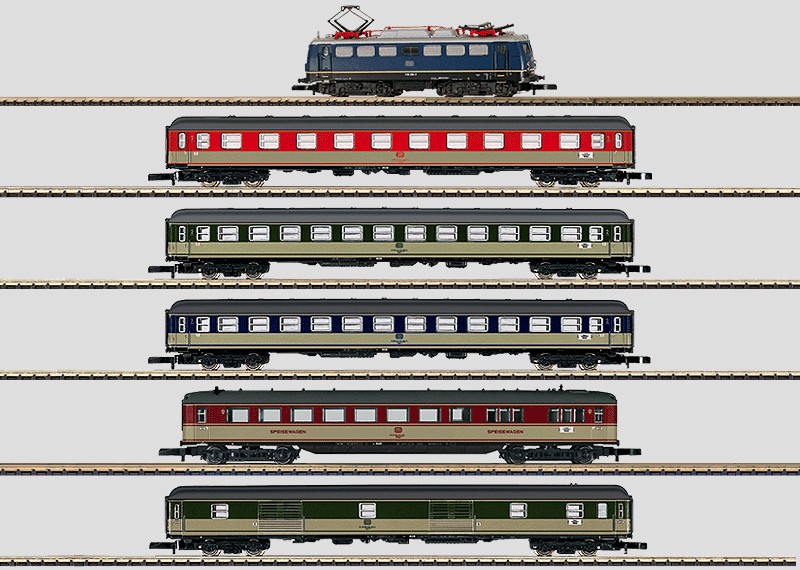Express Train Set.

| Article No. | 81435 |
|---|---|
| Gauge | Z |
| Design type | 1:220 |
| Era | IV |
| Kind | Train Sets |
Product description
Model: The locomotive comes with a 5-pole motor. Both trucks powered. The cars have lettered train destination signs. Total length over the buffers 691 mm / 27-3/16".
One-time series.
Publications
- New items brochure 2004 - Product programme 2005 - Product programme 2006Prototype information
German society changed in the 1960"s. The youth revolt broke the hardened political lines. Artists rebelled with Pop Art against traditional ways of seeing things. The exhilarating and easily digested fare penetrated all areas of life. The glass tent architecture for Munich"s Olympia Park also struck the observer as light and exhilarating. The graphic artist, Otl Aicher, created a visual concept for the 72 Olympic Games that included the pastel color tones of the rainbow. The German Federal Railroad also followed the trend. The sad, dark green of the passenger cars dampened the spirit. Using the model of the special paint scheme of the Rheingold, the company sought more modern, fresher, more dynamic colors for the express trains, which would enhance the image of the DB. In 1970, the DB commissioned 16 express train cars in cobalt blue/pebble gray. The colors chrome oxide green/pebble gray were intended for a second series of 24 cars. The new colors met with little enthusiasm from passengers, and little enthusiasm internally at DB. Only the pebble gray side walls were convincing; brighter friendlier colors were desired for the window strips. In the second approach there were cars with blood orange, cobalt blue, blue-lilac, scarlet, reddish violet, and green window strips. The side walls were pebble gray, the side sills and frame were deep black, and the roofs were umbra-gray. 1st class cars were marked with a yellow-gold identifying stripe. Thereafter, a portion of the 1st and 1st/2nd class coach cars delivered in 1970/71 were painted orange, 2nd class cars and 2nd class cars with a baggage compartment were painted blue, dining cars and sleeping cars, as well as half dining cars, were painted red, and baggage cars were painted green. The unusual rich coloring resulted in the nickname "Pop Cars". A total of 146 cars were given the pop color treatment. The DB mostly sent trains in this pure assortment of colors from Bremen, Osnabrück, Norddeich and Dortmund to Munich. In addition, pop trains traveled the Basel - Hamburg route, later as DC trains as well. Due to the pop colors, the closed effect of the window strip made the cars look elongated and modern. Other railroads copied the effect. The pebble-gray side walls however proved to be very susceptible to dirt. Consequently, in 1974 the DB selected ocean blue/beige as new standard colors. In 1985, the last pop cars were stationed in Munich. A little while later, the DB returned to essential design elements of the pop cars for its new color concept for passenger cars.